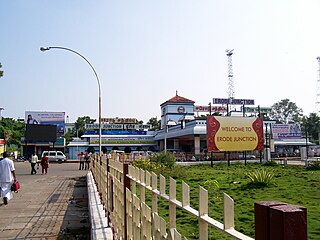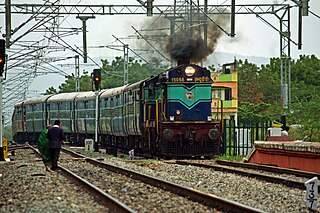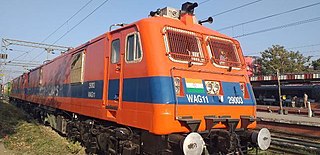Progress Rail Locomotives, doing business as Electro-Motive Diesel (EMD) is an American manufacturer of diesel-electric locomotives, locomotive products and diesel engines for the rail industry. The company is owned by Caterpillar through its subsidiary Progress Rail Services.

Chittaranjan Locomotive Works is a Government electric locomotive manufacturer based in India. It is located at Chittaranjan in Asansol Sadar subdivision with an ancillary unit in Dankuni. It is the largest locomotive production unit in the world with a record of 431 locomotives produced in the year 2019-20. Almost all electric locomotives running on Indian Railways are manufactured at CLW.

The Indian locomotive class WDM-2 is a class of diesel-electric locomotive that was developed in 1962 by American Locomotive Company (ALCO) for Indian Railways. The model name stands for broad gauge (W), Diesel (D), Mixed traffic (M) engine, 2nd generation (2). They entered service in 1962. A total of 2700+ WDM-2 was built at ALCO and Diesel Locomotive Works (DLW), Varanasi between 1962 and 1998, which made them the most numerous class of mainline diesel locomotive until its successor the WDM-3A.

The EMD GT46MAC is a freight-hauling diesel-electric locomotive with AC electric transmission designed by General Motors Electro-Motive Diesel in 1997–1998 for Indian Railways, where they are classed as WDG-4. Thirteen were built by EMD as order #958647, and a further eight were exported in kit form and assembled in India. The class entered service in 1999.

The EMD GT46PAC or WDP4 is a passenger-hauling diesel-electric locomotive with AC electric transmission designed by General Motors Electro-Motive Division and built by both GM-EMD and under license by Diesel Locomotive Works (DLW) of Varanasi, India for Indian Railways as the classes WDP4, WDP4B and WDP4D. The GT46PAC is a passenger version of the previous Indian Railways EMD GT46MAC freight locomotive. The locomotive has a 16-cylinder 710G3B diesel engine and is one of the fastest diesel-electric locomotives in service in Indian Railways.

The ALCO DL560C is a series of diesel-electric locomotive with AC electric transmission designed by the American Locomotive Company and produced under license by Diesel Locomotive Works (DLW) Varanasi, India for Indian Railways as their classes WDM-2, WDM-3A/2C, WDM-3D and WDG-3A for operation in India. The locomotive is fitted with a 16-cylinder ALCO 251 B,C diesel engine. In the early 1960s Indian Railways needed a reliable diesel workhorse to gradually replace its steam locomotive fleet. Equal numbers of ALCO's DL560C and EMD's SD24 were chosen for trials. More locomotives of each of these were purchased for more trials. Indian Railways was keen on producing these locomotives in the country rather than depending on imports. EMD did not agree for a Transfer-of-Technology, while ALCO did. Thus ALCO DL560C was chosen for the job due to its easy maintenance, reliability and simple operation. And from then on vast numbers of this loco in different configurations have been produced and they still continue to dominate the diesel route of Indian Railways.

Erode Junction railway station is the main railway junction serving the city of Erode, Tamil Nadu. Erode Junction is one of the major railway Junction in Southern Railway and is located near Erode Central Bus Terminus. There is an ISO certified diesel locomotive shed and an electric loco shed attached with Erode Junction.

The Indian locomotive class WDM-3A is a class of diesel-electric locomotive that was developed in 1993 by Diesel Locomotive Works (DLW), Varanasi for Indian Railways. The model name stands for broad gauge (W), Diesel (D), Mixed traffic (M) engine, with 3300 horsepower (3A). The WDM-3A is a later classification of earlier WDM-2C. They entered service in 1994. A total of 143+ WDM-3A was built at ALCO and Diesel Locomotive Works (DLW), Varanasi between 1994 and 2003 with rest of the 1246 units being rebuild from WDM-2 which made them the most numerous class of mainline diesel locomotive until the WDG-4.
Salem division is one among the six divisions of Southern Railway zone. Its headquarters is at Salem, Tamil Nadu.

The Varanasi–Jaunpur City-Sultanpur-Lucknow line is a railway line connecting Varanasi and Lucknow, both in the Indian state of Uttar Pradesh. This line is under the administration of Northern Railway and Lucknow Charbagh Divisions.

The Electric Locomotive Factory, Madhepura is a joint venture of Alstom SA of France with Indian Railways for the production of 800 high-power locomotives over a period of 11 years designed to run on Indian tracks at 120 km per hour. The manufacturing has started on 11 October 2017.

Gonda Junction Railway Station is a very big railway station in Devipatan division, Gonda district, Uttar Pradesh. Its code is GD. It serves Gonda city. The station consists of five platforms. It has good connectivity via roadways. It has various facilities like Escalator, Elevator, Free Wi-Fi, ATVM, Dormitory, Food Stall, Parking.
The Diesel Locomotive Factory, Marhowrah is a joint venture of GE Global Sourcing India Pvt. Limited of the US with Indian Railways for the production of 1000 high-power freight locomotives over a period of 10 years designed to run on Indian railway tracks. This factory started manufacturing the locomotives from September 2018.

The Indian locomotive class WDM-3D is a class of diesel-electric locomotive that was developed in 2003 by Diesel Locomotive Works (DLW), Varanasi for Indian Railways. The model name stands for broad gauge (W), Diesel (D), Mixed traffic (M) engine with 3300 horsepower (3D). The engine is classified WDM-3D though it outputs only 3300 hp and not 3400 hp as the name should suggest. They entered service in 2003. A total of 590+ WDM-3D were built at Diesel Locomotive Works (DLW), Varanasi between 2003 and 2016.

The Indian locomotive class WDP-1 is a class of diesel-electric locomotive that was developed in 1995 by Diesel Locomotive Works (DLW) for Indian Railways. The model name stands for broad gauge (W), Diesel (D), Passenger traffic (P) engine, 1st generation (1). They entered service in 1995. A total of 69 WDP-1 units were built at Diesel Locomotive Works (DLW), Varanasi between 1995 and 1999.

The Indian locomotive class WDP-3A is a class of diesel-electric locomotive that was developed in 1998 by Diesel Locomotive Works (DLW), Varanasi for Indian Railways. The model name stands for broad gauge (W), Diesel (D), Passengers traffic (P) locomotive with 3100 horsepower (3A). The WDP-3A is a later classification of earlier WDP-2. They entered service in 1998. A total of 44 WDP-3A units were built at Diesel Locomotive Works (DLW), Varanasi between 1998 and 2001.

The Indian locomotive class WDG-3A is a class of diesel-electric locomotive that was developed in 1994 by Diesel Locomotive Works (DLW),Varanasi for Indian Railways. The model name stands for broad gauge (W), Diesel (D), Goods traffic (G) engine, 3100 Horsepower (3A) locomotive. They entered service in 18 July, 1995. A total of 1164 WDG-3A units were built between 1994 and 2015 at DLW, Varanasi with a few units being produced by Diesel Loco Modernisation Works (DLMW) and Parel Workshop.

WDG-6G is a class of diesel-electric locomotive used by the Indian Railways for freight duty. The locomotive is a higher power variant of the WDG-4G locomotive which was also designed by General Electric. The design platform is based on the GE Evolution Series and features a 4-stroke 16-cylinder fully turbocharged engine which delivers around 6,000 horsepower.

The Indian locomotive class WAG-11 is a class of twin-section 25 kV AC electric locomotives that was developed in 2018 by Banaras Locomotive Works (BLW), Varanasi for Indian Railways. The model name stands for broad gauge (W), Alternating Current (A), Goods traffic (G), and 11th in series (11). They entered trials service in 2019. A total of 3 WAG-11 pairs have been built by Banaras Locomotive Works (BLW), Varanasi.

Diesel Loco Shed, Krishnarajapuram is a motive power depot performing locomotive maintenance and repair facility for diesel locomotives of the Indian Railways, located at Krishnarajapuram (KJM) of the South Western Railway zone in the city of Bengaluru, Karnakata. It is one of two diesel loco sheds of the South Western Railway, the others being at Hubli.



![ddiis[?] enyci[?], broodd geej.jpg](http://upload.wikimedia.org/wikipedia/commons/thumb/1/1c/%E0%B4%A1%E0%B5%80%E0%B4%B8%E0%B5%BD_%E0%B4%8E%E0%B4%9E%E0%B5%8D%E0%B4%9A%E0%B4%BF%E0%B5%BB%2C_%E0%B4%AC%E0%B5%8D%E0%B4%B0%E0%B5%8B%E0%B4%A1%E0%B5%8D_%E0%B4%97%E0%B5%87%E0%B4%9C%E0%B5%8D.jpg/220px-%E0%B4%A1%E0%B5%80%E0%B4%B8%E0%B5%BD_%E0%B4%8E%E0%B4%9E%E0%B5%8D%E0%B4%9A%E0%B4%BF%E0%B5%BB%2C_%E0%B4%AC%E0%B5%8D%E0%B4%B0%E0%B5%8B%E0%B4%A1%E0%B5%8D_%E0%B4%97%E0%B5%87%E0%B4%9C%E0%B5%8D.jpg)


























